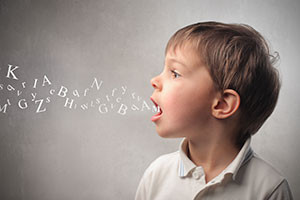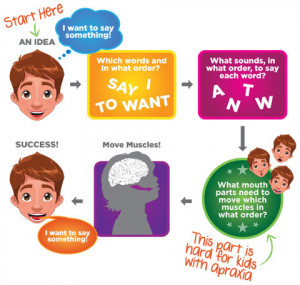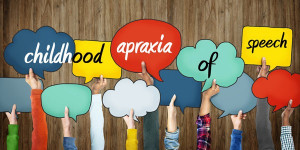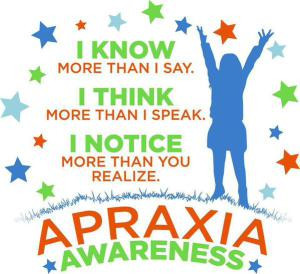
Childhood Apraxia of speech (CAS)
Childhood Apraxia of speech (CAS)
What is Childhood apraxia of speech CAS?
Childhood apraxia of speech (CAS) is a motor speech disorder that affects a person’s ability to organise the movements of the muscles used in speech. CAS is a neurological disorder that affects the brain pathways involved in planning the sequence of movements involved in producing speech. The brain knows what it wants to say, but cannot properly plan and sequence the required speech sound movements. The person has difficulty making speech sounds voluntarily and stringing these sounds together in the correct order to make words.
Childhood apraxia of speech can continue into adult life. CAS is not caused by weakness or paralysis of the speech muscles (the muscles of the jaw, tongue, or lips). The difficulty seems to occur because of a breakdown in the program of movement sent from the brain to the muscles. This does not mean that the person has an intellectual impairment.
The severity of CAS varies from person to person. It can be so mild that it causes trouble with only a few speech sounds or with pronunciation of words that have many syllables. In the most severe cases, someone with CAS might not be able to communicate effectively by speaking, and may need the help of alternative communication methods.
What are the signs and symptoms of childhood apraxia of speech in young children?
Some characteristics, called markers, help distinguish CAS from other types of speech disorders. Those particularly associated with CAS include:
- Difficulty moving smoothly from one sound, syllable or word to another
- Groping movements with the jaw, lips or tongue to make the correct movement for speech sounds
- Vowel distortions, such as attempting to use the correct vowel, but saying it incorrectly
- Using the wrong stress in a word, such as pronouncing “banana” as “BUH-nan-uh” instead of “buh-NAN-uh”
- Using equal emphasis on all syllables, such as saying “BUH-NAN-UH”
- Separation of syllables, such as putting a pause or gap between syllables
- Inconsistency, such as making different errors when trying to say the same word a second time
- Difficulty imitating simple words
- Incorrect use of prosody.
- Inconsistent voicing errors, such as saying “down” instead of “town,” or “zoo” instead of “Sue”
Articulation errors may include:
- Substituting sounds, such as saying “fum” instead of “thumb,” “wabbit” instead of “rabbit” or “tup” instead of “cup”
- Leaving out (omitting) final consonants, such as saying “duh” instead of “duck” or “uh” instead of “up”
- Stopping the airstream, such as saying “tun” instead of “sun” or “doo” instead of “zoo”
- Simplifying sound combinations, such as saying “ting” instead of “string” or “fog” instead of “frog”
 Red flags:
Red flags:
When child is younger than 3 years old and
- Does not coo or babble as an infant.
- Says her first words later than you think she should.
- Says only a few different sounds.
- Has problems putting sounds together.
- Puts long pauses between sounds she says.
- Does not always say a word the same way.
- Has some problems eating.
When child is older than 3 years old and
- Does not always say words the same way each time he says them.
- Can understand what others say to him better than he can talk.
- Has problems imitating what others say. If he can imitate, those words will sound better than words he says on his own.
- Seems like he has to move his lips, tongue, or jaw a few times to make sounds. This is called groping.
- Has more trouble saying longer words clearly than shorter ones.
- Seems to have more trouble talking when he is nervous.
- Is hard to understand, especially for someone who doesn’t know him well.
- Sounds choppy or flat. He may put the stress on the wrong syllable or word.
There are some other problems that the child may have that could put her at risk for CAS. These include:
- Speech and Language delay.
- Problems with fine motor skills, like drawing, writing, or picking up small things.
- Problems with how she feels things in her mouth. She may be very sensitive and not like to have her teeth brushed or eat crunchy foods. Or, she may not be very sensitive and may not feel hot or cold very well.
- Learning problems. Children with CAS or other speech problems may have problems learning to read, spell, and write.
Other problems associated with CAS
A child who has a diagnosis of CAS may also experience:
- feelings of frustration because he can’t get their message across
- oral language difficulties, such as the ability to turn sounds into meaning
- difficulties with reading and spelling
- difficulties with other motor skills, such as using scissors, writing or riding a bike
- sucking, chewing and swallowing problems
- difficulty performing movements with their tongue and lips when asked to do so
- clumsiness.
Causes of Childhood Apraxia of Speech
CAS is a motor speech disorder. Something in the child’s brain does not allow messages to get to his mouth. Most of the time, the cause is unknown. It is possible that nothing would show up if you had tests done, like an MRI or CT scan of the child’s brain. This can be frustrating as you look for a reason for the child’s speech problems.
In some cases, the child may have brain damage that causes Childhood Apraxia of Speech. The child may have a genetic disorder or syndrome that causes brain damage. A stroke or brain injury can also cause CAS.
 How is apraxia of speech diagnosed?
How is apraxia of speech diagnosed?
Currently, there is no validated list of diagnostic features differentiating CAS from other childhood speech sound disorders, including those due to phonological-level delay or neuromuscular disorder (dysarthria). However, three segmental and suprasegmental features consistent with a deficit in the planning and programming of movements for speech have gained some consensus among those investigating CAS:
- inconsistent errors on consonants and vowels in repeated productions of syllables or words,
- lengthened and disrupted coarticulatory transitions between sounds and syllables,
- inappropriate prosody, especially in the realization of lexical or phrasal stress.
For the testing of oral-motor skills, the SLP will:
- Check for signs of lip, jaw, or tongue weakness, called Dysarthria. Most children with CAS do not have weakness, but it is important to check.
- See how well the child can move his mouth. The SLP may ask him to copy movements like smiling, sticking out her tongue, and puckering his lips.
- Test how well the child can make fast mouth movements. This tells the SLP how well he can coordinate his movements since our mouths move fast when we talk.
- See how well the child can do “real-life” mouth movements like licking a lollipop. The SLP will compare that to how well he can do the same thing when pretending. A child with CAS may be able to do a movement when he doesn’t think about it but not when asked to do it.
For the testing of the speech melody, called intonation, the SLP will:
- Listen to how the child puts stress on syllables and words in sentences. When you get a gift, you call it a “PREsent.” The stress is on the first syllable. When you give a speech, you “preSENT.” The stress is on the second syllable. Children with CAS may have trouble putting stress on the right syllables.
- See if the child can change his pitch to ask questions or make statements. Think about how you say “Hello?” when you answer the phone. Your pitch goes up at the end of the word because you are asking a question. Now think about how you say “Hello” to someone who walks into a room. You say the same sounds, but your pitch changes. Children with CAS may have trouble changing pitch correctly.
- See how the child uses pauses to mark different parts of a sentence. When you say, “We went to the store, then back home,” you pause after the word “store” to mark a change in the sentence. Children with CAS may put pauses in the wrong place or not use them at all.
For testing how the child says sounds, the SLP will:
- Test both vowel and consonant sounds. Vowels are sounds like A, E, I, O, U, and consonants are sounds like B, G, M, R, S.
- Check how well the child says sounds alone and combined in syllables or words.
- Check how well others can understand what the child with CAS says.
How is apraxia of speech treated?
Type of treatment a child with CAS should work with an SLP. Research shows that the child with CAS will do better with therapy 3–5 times per week. As he improves, he may need treatment less often. As the child works on learning to make sounds and words, it is better for him to be seen alone. A group may be good when he works on using sentences to talk with others.
Treatment Goals:
The goal of treatment is to help the child say sounds, words, and sentences more clearly. The child needs to learn how to plan the movements he needs to say sounds. Then he needs to learn how to make those movements the right way at the right time. Doing exercises to make his mouth muscles stronger will not help. His muscles are not weak if he has CAS. Working on how to move those muscles to say sounds will help.
The child must practice speaking to get better at it. It helps to use all of his senses as he learns how to say sounds. He may use “touch” cues, like putting his finger on his lips when saying the “p” sound to remind him to close his lips. Or, he may use visual cues, like watching herself in a mirror. Hearing how he sounds on a recording can help, too. This sensory feedback can help your child repeat sounds and words and start using them in longer sentences.
Alternative ways of communication:
Some children with apraxia have a hard time saying anything at all.
- The child with CAS may be taught sign language or may learn to use picture boards or computers that talk for him. This is called augmentative and alternative communication.
- use gestures or pictures or touch specific points on the face or neck to help the person make the right sound or sequence of sounds
- introduce other ways to communicate, such as communication boards, key word signing or voice output devices. This will also help to reduce some of the frustration that naturally occurs if a person has difficulty getting their message across.
If you wish to know more about Speech Therapy, kindly contact us at info@1specialplace.com
For more ideas check out our other blogs
- Birth – 1 Year : Speech & Language Milestones - December 22, 2022
- Amazing Apps for Speech therapy - October 1, 2018
- Childhood Apraxia of speech (CAS) - September 8, 2018



Leave a Comment
(0 Comments)